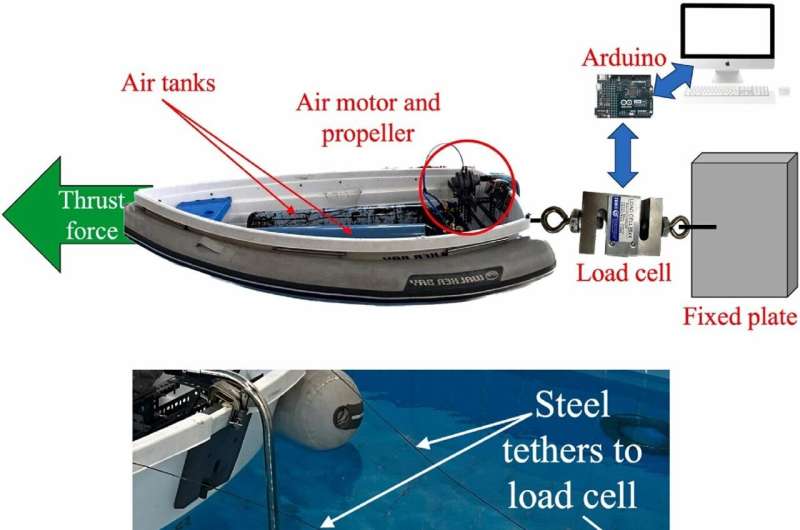
September 9, 2024 by University of Sharjah
Collected at: https://techxplore.com/news/2024-09-scientists-air-propeller-vessels-ferries.html
Scientists say they have designed a propeller system that can replace electrical and diesel-operated engines currently used to drive ferries plowing through the seas on pre-determined routes.
The propulsion system was created by a team at the University of Sharjah, and it is touted as more feasible economically, more efficient in terms of energy use than conventional engines, but more importantly it is friendly to the environment.
“The pneumatic system would prove more feasible both economically and from an energy efficiency perspective. The on-board compressed air tanks that drive an air motor, which in turn rotate the propeller, can be refilled with air at the end of the trip while waiting for passengers to board,” said team leader Abdul Hai Alami, who is University of Sharjah’s Professor of Sustainable and Renewable Energy Engineering.
The scientists describe their invention as a bold step on the path of the transition from conventional engines to pneumatic propulsion. They forecast profound environmental benefits, such as reducing aerial emissions, water pollution from fuel and engine oils and excessive noise reduction.
Their research is reported in the journal Ocean Engineering in which the scientists outline their project studying the impact of equipping ferry boats with a pneumatically operated propeller to replace diesel-driven engines.
They write, “In this paper, an alternative propulsion method is proposed in the form of a pneumatically powered boat. The system is powered by an air motor-mounted propeller fed by an onboard compressed air tank(s).
“In contrast to typical propulsion systems, compressed air systems offer effective, clean, and sustainable propulsion systems. The system performance was analyzed and compared with that of an electrical propulsion system powered by electrochemical batteries.
“In addition, a life cycle analysis was conducted to quantify any reduction in carbon dioxide emissions due to the utilization of the pneumatic system.”
Prof. Alami said the pneumatic propeller his team created was tested on vessels transporting passengers and cargo on pre-determined routes in the United Arab Emirates (UAE). Famous for their popular name of Abra, these ferry boats are part of the country’s maritime culture and one of its main tourist attractions.
“The experimental results proved that compressed air is an effective alternative to electrical motors in terms of eco-friendliness, effectiveness, and sustainability,” the researchers note. “The pneumatic system provided a 6% extra propulsion force and a carbon footprint saving of 307 kgCO2/year over their electrical counterparts.”
Co-author Ahmad Yasin, a research assistant at Sustainable Energy and Power Systems Research Center (RISE), recounted numerous advantages for the pneumatic propeller over its diesel or electrical counterparts.

“Reduction of energy requirements, pollution and noise make the proposed boat pneumatic engine an attractive solution,” he said. “Life-cycle assessment proves that the carbon footprint of the equipment and materials used are far less than conventional electric propulsion systems.”
Maitha Almheiri, a co-author and a student in the Sustainable and Renewable Energy Engineering Department, predicted their invention would eventually become the means to drive cargo and passenger ferries over pre-determined maritime routes.
“Pneumatic engines for maritime propulsion would practically replace diesel and electric engines,” she said.
In their paper, the researchers provide evidence that “pneumatic systems offer a real advantage over other propulsion methods for ferryboat applications, which are defined by a constant trip length and path.”
Prof. Alami highlighted the main goal of the project, which he said was “to provide experimental information on the suitability of pneumatic propulsion for maritime transportation.
“The positive impacts on the marine environment are multifold, including lower pollution, noise reduction and significantly lower emissions.
“While it may not be suitable for leisure cruising purposes, the operation of the pneumatic system is well-suited for ferrying passengers between predefined stops.”
The scientists are currently exploring possibilities for utilizing their pneumatic power-driven machine and getting their proposed system installed in vessels in the UAE.
Prof. Alami said his team saw the installation of the system between the current ferry stops in Dubai as practically achievable, with compressed air tank recharge taking place while waiting for passengers to disembark and others to board.
“This sheds light on another advantageous aspect of pneumatic propulsion through rapid charge rates compared to electric systems as well as competing-well with diesel filling time.
“The proposed system has a much lower carbon footprint due to straightforward recyclability of the components that do not contain dangerous chemicals or reactive materials as is the case with battery-operated propulsion.”
The team is currently cooperating with two UAE establishments to industrialize their project. They have already introduced their pneumatic propeller to the Road and Transportation Authority in Dubai and the Sharjah Water Sports Club, which is equipped with a boat manufacturing facility.
More information: Abdul Hai Alami et al, Experimental design and testing of a pneumatic propulsion system for maritime transportation, Ocean Engineering (2024). DOI: 10.1016/j.oceaneng.2024.118335

Leave a Reply